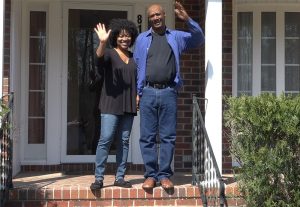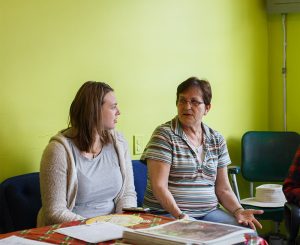The Changing Nature of Rural Electric Cooperatives in the 21st Century
By Rory McIlmoil, Appalachian Voices Energy Policy Director
When people think of their electric utility, they don’t usually think about how it operates, or whether it invests in clean energy or could help reduce their energy costs. But this is changing as people struggle to pay their electric bill and as residents grow more concerned about their health, the environment and their local economies.

Larry and Deborah Freeman are Roanoke Electric members who benefited from the Upgrade to $ave program. Photo courtesy of Roanoke Electric Cooperative.
After more than a century of primarily generating and selling electricity, many utilities are exploring new business models that better respond to customer needs and the changing electricity market. Rural electric cooperatives, which account for 10 percent of all electricity sales in the United States, are leading the pack in changing how they do business.
“Co-ops are looking at the best way to serve their consumers and provide them with a variety of services,” said Nelle Hotchkiss of the North Carolina Electric Membership Corp. “It’s not just about providing electrons anymore.”
That mindset is the driving force behind new energy efficiency and renewable energy programs being developed by electric co-ops across the country. Many of the most prominent examples have been developed in Appalachia and the Southeast. However, co-ops will have to work closely with the communities they serve if these programs are to reach the scale required to have a significant impact on local economies and the environment. Fortunately, that spirit of cooperation lies at the core of the co-op mission.
Electric Co-ops and America’s Energy Future
Rural electric co-ops are not-for-profit electric utilities owned by their customers, who are considered co-op members. Each member owns an equal vote in electing the Board of Directors — the primary decision-making body of the co-op — and therefore have a strong voice in how their utility is operated.
The nation’s first rural electric co-op was established in Tacoma, Washington in 1914. Over the next two decades, only eight more electric co-ops were developed, and by the mid-1930s only 10 percent of rural homes had electricity, according to the National Rural Electric Cooperative Association.

John Kidda, owner of reNew Home Inc , performs an energy audit as part of Appalachian Voices’ home energy makeover contest in 2015.
Recognizing the need to extend power into rural areas, the federal government encouraged the growth of electric co-ops through a series of initiatives launched in the 1930s. These programs expanded access to the financial resources needed to electrify rural communities, and residents came together and formed their own rural electric co-ops, building the electrical lines and constructing the power plants themselves in some cases.
Today, there are more than 900 electric co-ops serving 42 million people in 47 states. Most co-ops still obtain most of their electricity from large coal, gas and nuclear power plants, which accounts for a lot of the country’s carbon emissions and other energy-related pollution. Rural co-op areas also have a higher concentration of older, drafty homes, meaning that more energy is wasted per customer than is for customers of other electric utilities.
Reducing that waste through increasing energy efficiency and developing more renewable energy would have substantial environmental benefits, eliminating millions of tons of carbon emissions each year and cutting down on other air and water pollution. But it would also have a profound impact on families and local economies.
The average poverty rate in co-op service areas, particularly in Appalachia and the Southeast, is often higher than the national average. With costs for electricity higher in rural areas, co-op members ultimately spend a disproportionate amount of their income on their energy bills. This poses a significant burden on low-to-moderate income residents, exacerbating poverty and diverting money away from local economies.
All this means that there is an opportunity for co-ops to rethink how they provide power to rural areas and manage energy demand. Yet not many co-ops have addressed these issues — until recently.
The Changing Electricity Market
“Would you believe that the people in this room, the people in the electrical industry, are a stubborn group of people?” asked Harold DePriest, CEO of the Electric Power Board of Chattanooga and former Chair of the Tennessee Valley Public Power Authority. “We don’t like to change.” DePriest was speaking at a meeting with representatives from approximately 155 municipal utilities and rural electric cooperatives in 2013, arguing that the utilities should be doing more for their members and communities. His point was that by offering programs that improve the lives of their customers, the utilities would discover a new way of doing business.
The U.S. electricity market is evolving from the traditional system of large, centralized power plants to a more efficient, distributed, customer-owned model at a pace much quicker than utilities are comfortable with. Following decades of rising electricity demand, sales are now shrinking due to energy efficiency, conservation and consumer-owned renewable energy. But this means that electric utility revenues are also declining.
In response, many rural electric co-ops are exploring new business models that meet the needs of their members while still generating the revenues they need to operate. “Co-ops by their very nature, because they are locally governed and responsive to their members, have the flexibility to be responsive [to new challenges],” Hotchkiss explains. “There is an evolution going on and we’re not immune to that, nor should we be. Embracing new opportunities is important.”
Many rural electric co-ops in Appalachia and across the Southeast are pursuing renewable energy and energy efficiency programs for their members. A handful of these co-ops are even going beyond energy and playing a more comprehensive role in economic development for their communities.
A Holistic Approach
Marshall Cherry, a native of Bertie County, N.C., has worked with Roanoke Electric Cooperative for 23 years and currently serves as the chief operating officer. “If I’m out in the community and people know me, and know that I work for the co-op, somewhere along the line the conversation does come up about electric bills,” he says.
Federal Financing
In early 2014 the U.S. Department of Agriculture launched the Energy Efficiency and Conservation Loan Program. So far, the program has announced more than $60 million in new loan guarantees to electric cooperatives and other utilities to implement on-bill energy efficiency finance and community solar programs to benefit rural areas.
Another new federal program will allow USDA to provide zero-interest loans to rural electric utilities for the utilities to offer on-bill financing to their customers. The Rural Energy Savings Program is expected to be available summer 2016.
According to Cherry, nearly 7 percent of the average household income in Roanoke Electric’s service area is spent on energy costs. This is roughly three times the national average, in an area where many members fall below the poverty line. “So when a member has an electric bill of $1,000 [for a single month], that is close to or above 40 percent of their income in many situations,” Cherry says. To address this problem, the co-op launched Upgrade to $ave, an on-bill energy efficiency finance program, in June 2015.
With on-bill financing, the electric utility pays for a contractor to make improvements, such as weatherization or more efficient heating and cooling systems, to a customer’s home. The resident then repays the utility through a new charge on their bill which is more than offset by the amount they save on their energy bill from the improvements. With Upgrade to $ave, the customer keeps at least 25 percent of the savings. The remainder goes to Roanoke Electric to repay the cost of the improvements.
In other words, despite an added charge on their bill, nearly all customers start to see an immediate reduction in their electricity costs as a result of the efficiency improvements. Once the utility has been reimbursed, 100 percent of the savings are kept by the customer.
Under this model, eligibility for financing is determined by a customer’s bill payment history, not a credit check, and the repayment is attached to the property and not the individual. This allows all residents with good utility bill payment history, including residents of low-income and rental properties to access financing they couldn’t obtain elsewhere.
The results expected by Roanoke Electric are impressive. The first group of retrofitted homes are projected to save nearly $600 a year on their electric bills, even after factoring in the new charge for the upgrades. To fund the program, the co-op received a $6 million federal loan guarantee to help finance energy improvements on as many as 1,000 homes over four years.
The co-op also saves money by not having to purchase as much power during peak hours when electricity is most expensive. “There is a business case for us because we’re more than able to recapture the costs and losses through the financial benefits we receive,” says Cherry.
Roanoke Electric is becoming more service-oriented for their members, offering new opportunities like a community solar program, high-speed internet and a workforce training program for energy efficiency contractors, among other programs.
“We’re now able to offer a package of services that holistically improves the quality of life for our members,” concludes Cherry.
A New Model in Tennessee
Thousands of U.S. residents struggle to pay their electric bills each year, especially in the winter months when heating costs skyrocket. Many residents have to apply for federal funds through the Low-Income Home Energy Assistance Program to keep the electricity on. LIHEAP funding is limited, however, so residents are often competing for assistance.
One resident from Tazewell, Tenn., a member of Powell Valley Electric Cooperative, shared her experience with applying for LIHEAP funding. “For years, to get assistance with our electric bills we sat out [by the weatherization assistance agency’s building] all night,” she recalled. “You had to get there the night before because they only had enough [funding] for so many applications. I would sit there and I would doze off and when I woke I had snow on my blanket.”
“The line would go all the way out around the food stamp office and back down the highway.” she said.

Amy Kelly of Appalachian Voices, speaks with a volunteer at a hunger ministry about the burden of high energy costs in Tazewell, Tenn.
And while the LIHEAP program helps families pay their energy bills, it doesn’t address the underlying problems of poverty and energy waste in homes. The only other source of funding available, the federal Weatherization Assistance Program, provides just enough funding to weatherize about 800 homes a year in Tennessee — a drop in the bucket compared to what the U.S. Census Bureau identifies as more than 700,000 homes in poverty and 1.2 million homes that are over 35 years old in the state. Even though most Tennessee co-ops and municipal utilities offer energy efficiency loan programs, many residents aren’t eligible because they don’t own their home or fail to meet the credit requirements.
But thanks to the leadership of a handful of co-ops, a new opportunity is launching this year that will be available for residents of all income levels, as well as renters.
“We see members every month who do not qualify for current energy efficiency programs due to their credit score, yet they are good electric bill payers,” says Greg Williams, general manager of Appalachian Electric Cooperative. “We also see every winter members who simply struggle to pay high bills. Helping our members to improve their quality of life is foundational to who we are and that includes helping them lower their electric bill.”
A new statewide on-bill finance program — expected to be launched this fall — is a direct result of the efforts of Appalachian Voices, which is the publisher of this newspaper, and of Appalachian Electric Cooperative’s commitment to finding new energy solutions for its members. The conversation began three years ago, and generated additional interest from the Tennessee Electric Cooperative Association as well as support from the state Department of Environment and Conservation, the program is expected to launch this fall.
While only Appalachian Electric has committed to the program thus far, as many as 10 of the state’s co-ops are expected to participate. Williams hopes to see the program expand even further. “If we could get every co-op in the state to adopt this program, that would be amazing and would create an enormous impact across the state for energy efficiency,” he says.
Responding to growing member interest in solar energy, Appalachian Electric is also developing a community solar program that allows members to lease solar panels and earn a credit on their electric bill for the power generated by the panels. In total, the project will cover the energy needs of more than 100 homes. While this is a significant achievement, it represents less than a half percent of the co-op’s total membership.
A number of factors are working together to limit the amount of solar that co-ops can develop. As demand for solar from co-op members grows and the price continues to fall, co-ops that want to meet that demand and keep up with the changing market will need to develop new solutions.
“The Utility of Today”
In 2013, Blue Ridge Electric Membership Corp. was one of the first co-ops Appalachian Voices reached out to when advocating for on-bill financing. Blue Ridge Electric is one of the largest electric co-ops serving Appalachia. Following a number of meetings with co-op executives, it became clear that there was only one way they would consider creating such a program.

Mary Ruble, a Blue Ridge Electric member, discusses efficiency with stakeholders at a community meeting.
“They kept telling us they needed to hear from the members,” Ashe County, N.C., resident Mary Ruble said in an interview with the national nonprofit WeOwnIt. “So we got over 1,000 signatures from co-op members on a petition,” she said. “We got publicity. We went to the annual meeting. We made sure they heard from members.”
Partnering with Appalachian Voices, Ruble and other community stakeholders expressed their support for an on-bill finance program, and in April of this year Blue Ridge Electric launched the Energy SAVER Loan Program. While renters are not eligible to apply, the program offers affordable loans for member homeowners to pay for energy efficiency improvements such as insulation and new heating systems.
Sean Dunlap — Story of Success
Blue Ridge Electric member Sean Dunlap lives with his wife and two children in a 1938 farm house built by his wife’s great-grandfather. Two years ago, the family was struggling with high heating bills and staying warm in the winter. “It was frustrating and expensive,” said Dunlap. “Having an infant in a house that gets really, really cold in the wintertime is stressful.”
In late 2014, the Dunlap family applied for Appalachian Voices’ Home Energy Makeover Contest and won $800 worth of insulation and air sealing. According to an analysis by the consulting firm ResiSpeak, those improvements saved the Dunlap’s nearly 10 percent on their energy bills in 2015. “We are so thankful for all of the work that was done on our house. We immediately began noticing an improvement in the comfort of our home and saved quite a bit on our heating costs last winter,” said Dunlap.
The current pilot program will finance $100,000 in energy retrofits during the first phase. If the program is successful, the co-op plans to expand it after the first year.
“We’re making life better for our members by offering a way for them to be able to afford a more comfortable and efficient home,” says Blue Ridge Electric’s Energy Efficiency Marketing Manager Jon Jacob. “Even those who don’t participate benefit because energy efficiency is integral to helping us keep our rates from going up.”
The program isn’t the first of its kind to be developed in western North Carolina. French Broad Electric Membership Corp. launched an on-bill financing program in 2013 and has financed nearly $1 million in new energy efficient heat pumps for its members.
French Broad’s Director of Member Services Sam Hutchins got the idea for the program from his own experience with high energy bills. “Several years ago, I received a $500 December power bill for my double wide [manufactured home] that had an old electric furnace,” he says. “I knew I could not afford to continue heating that way. Through internet research I found [high efficiency] heat pumps. If that was the answer for me, I knew it could help others.”
These two programs are having an immediate economic impact, not only through saving co-op members money, but by hiring local contractors to make the improvements and install the heating systems.
“On-bill financing for energy efficiency improvements represents our best chance to provide good local jobs and reduce our energy consumption,” says Sam Zimmerman, president of Sunny Day Homes and one of Blue Ridge Electric’s program contractors as well as an Appalachian Voices supporter. “Brought to scale this program would demonstrate that what helps the environment sometimes helps the economy even more.”

A High Country Energy Solutions employee weatherizes Sean Dunlap’s home.
Due to rising demand from their members, Blue Ridge Electric is also in the process of developing a community solar project that will generate enough electricity at the start to power about 50 homes. The co-op is also exploring services like integrating battery storage into their grid, providing a rooftop solar option and selling home energy management technologies.
“As part of our changing business model, we have to find ways to fund clean energy projects through other revenue sources,” says Jacob. When asked whether Blue Ridge Electric was becoming a “utility of the future,” he responded, “It’s no longer ‘of the future,’ but rather ‘utility of today.’ It’s happening now.”
Cooperation is the key
Despite the progress made by Appalachian co-ops, the programs are still relatively new and have yet to make a significant dent in reducing energy waste and driving local economic development. Less than one-third of the co-ops serving central Appalachian communities have developed or committed to on-bill finance programs. Even where the programs exist, achieving the level of investment and participation that is possible in the region is proving to be a challenge.
Chris Woolery of the Mountain Association for Community Economic Development coordinates the How$mart Kentucky on-bill finance program, which launched in 2010 and currently has six participating co-ops. Yet in six years fewer than 500 homes have benefitted. But Woolery has an idea of what’s needed to expand that impact. “We want to see energy efficiency as an economic driver in the region,” he says. “That requires bringing the community together and creating advocates for this kind of program one household at a time.”
Appalachian Voices’ Energy Savings for Appalachia campaign is promoting on-bill energy efficiency financing through rural electric cooperatives serving western North Carolina and eastern Tennessee. To learn more visit: AppalachianVoices.org/EnergySavings
Related Articles
Latest News

Leave a comment
Your email address will not be published. Required fields are marked *




